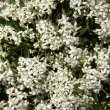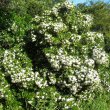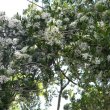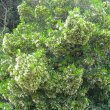| Botanical Name |
|
| Family |
Rubiaceae - The gardenia and coffee family. |
| Pronunciation |
puh-VET-tuh lan-see-oh-LAY-tuh |
| Common Name(s) |
English: Christmas Bush; Weeping bride's bush
Afrikaans: Treurbruidsbos
IsiXhosa: Tshituku; Umhleza; Umphonyana
IsiZulu: umdleza; igololembuzi
Tshivenda: mufhanza; tshituku
|
| Plant Group |
- Tree A woody, self-supporting perennial plant usually with a single main stem and generally growing more than 6 meters tall.
|
| Plant Size |
- Very Small
| Tree | 3m to 4m |
| Shrub | 25cm to 50cm |
| Perennial/ground cover | Up to 10cm |
| Bulb | 10cm to 20cm |
| Succulent | Up to 5cm |
|
| Position |
- Canopy Shade Canopy shade is found below closely grown trees where some light filters through. Ideal for the protection of herbaceous plants.
- Light or Dappled Shade Found below trees with sparse, open foliage. Ideal for the protection of herbaceous plants.
- Partial Shade The area is in shade for part of the day and in full sun for part of the day.
- Sun The area is in full sun for all or most of the day, all year round.
|
| General Information |
- Drought Tolerance: Moderate The plant is moderately adapted to arid conditions and can survive short periods of drought and high temperatures without extra water.
- Evergreen Plants that have leaves all year round.
- Fragrant / Aromatic These plants posses a strong, usually pleasant odour.
- Frost: Tender A plant that will not survive any frost or low winter temperatures.
- Water Moderate These plants will need some extra watering compared to water-wise plants. Plant them together, in at least some shade and in a convenient proximity to the house so that grey water can be utilised during times of drought.
- Wind Tolerant Plants able to withstand the effect of strong winds.
|
| Specific Information |
As the end of the year approaches, Pavetta lanceolata makes its presence known with swathes of bright, white, sweetly scented veils decorating hedgerows and bush wherever it is found. The leaves of this small tree are glossy and dark green and the branches have a drooping habit. When not in flower Pavetta lanceolata makes a lush and dense green backdrop for other species. It grows well in the shade of larger trees and will tolerate light pruning.
|
| Ad Break |
|
| Flowers |
| Description |
masses of small star-shaped flowers in loose clusters at the ends of the branches
|
| Season |
- Spring to Summer Plants will seldom bloom for the entire season as given in the list, but should flower during a period within these parameters.
|
| Colour |
|
| Growth Rate |
- Moderate to Fast Specifying growth rate can be very misleading as there is considerable variation of growth rate depending on type and species of plant, available water, supplementary feeding, mulching and general care, as well as the plants suitability and adaptability to the garden environment.
|
| Plant Uses |
- Accent or Focal Point A plant used to attract the attention because of its colour or form.
- Attracts bees, butterflies or other insects This plant attracts insects which can be food for birds or other creatures in your garden.
- Attracts Birds This plant will attract birds.
- Boundary A plant useful for planting around the edges of the property to form a green or colourful backdrop, an impenetrable hedge, to hide walls or create privacy.
- Filler Either a fast growing tree or shrub used temporarily to fill in an area while the permanent plants grow to a desired size, or a plant used to fill gaps in borders or beds.
- Hedge Suitable trees or shrubs planted relatively close together so that the branches intertwine to create a barrier. This can be formal – the plants are regularly trimmed to produce a neat shape, or informal – the plants are left to themselves to create a natural hedgerow.
- Provides light / dappled shade A tree with an open to sparse canopy, through which varying degrees of sunlight can penetrate.
- Screen A tall hedge of suitable plants planted closely together and used as a windbreak, to block a bad view, to separate parts of the garden or as a backdrop.
- Suitable for coastal gardens Plants adapted to dry, sandy soil, forceful wind, limited rainfall and intense sunlight.
- Suitable for smaller gardens Such plants do not have invasive root systems, remain small or controllable and can often be grown in containers.
- Wild Garden An indigenous garden planted for the benefit of wildlife and birds. Provides food, water, a variety of mini-biomes and no poisonous chemicals are used.
|
| Distribution and Habitat |
in the Eastern Cape, KwaZulu-Natal, Mpumalanga and Limpopo, as well as Swaziland and southern Mozambique, in bush clumps, on forest margins and along river banks.
|
| Planting Suggestions |
Mulch well and water regularly during the first year or two for optimum growth. Plant two or three plants together if you wish to use it as an accent plant. It will need plenty of water and may be slow growing at first, but once well established it grows fast and watering can be reduced or stopped entirely, depending of course on the rainfall available.
The old method of digging a deep hole and filling it with soil and compost has resulted in many trees failing to thrive, dying, rotting at the base or worse still, falling over in later years due to poor root development. Refer to the following sites for the best method of planting trees:
Treehelp.com: Planting a tree
International Society of Arboriculture: New Tree Planting
Tree People: Plant the right way
For those of you who have a clay problem try:
Rod's Garden: Planting in clay soil
|
| Medicinal Uses |
|
| Ad Break |
|










Comments
Transplanting Bridal bushes
Hi,
Can I safely transplant/move a bridal bush (Pavetta lanceolata) in this season (mid-Ocotober?)
What steps should I take to ensure the plant's health.
Thanks!
Transplanting shrubs and trees
Hi Christy
I would not chance it now. Pavetta flowers from spring to summer - mine are already in bud. Moving it now would stress the plant and it may never recover properly. The best time would be early to mid winter. I am pretty sure that the pavettas do not have a particularly large root system
To ensure a successful transplanting, go to kumbulanursery.co.za/blog/planting-a-tree-or-large-shrub-the-basics.
Try www.ag.ndsu.edu/pubs/plantsci/trees/f1147w.htm
for Transplanting Trees and Shrubs, where you will be quided through the process of removing the shrub from the ground.
Pavetta Lanceolata Research.
where in Westville, Durban would i be able to find Pavetta Lanceolata?
Pavetta lanceolata
Hi Vanishree
If you have already enquired at the nurseries listed in the yellow pages and on the Web, I can only suggest you contact the Botanical gardens in Durban. They often have species that you can't get anywhere else.
You are the third person who has contacted me looking for this plant for research purposes. What is its importance as I have found no data regarding medicinal use?
Regards
Lorraine
Borers in Pavetta bushes
Hi. There seems to be an insect borer in my Pavetta bushes, causing a lot of die back.. I have sprayed (which I hate doing because of the birds) and I have cut back a lot of the branches. Any suggestions as to what the insects are and how to eradicate?
Thanks...
Wood or Stem borer insects
Hi Julie
There are hundreds of varieties of boring insects. You haven't mentioned if the insects concerned are boring into the wood through the outer bark or down through the stems, but in either case these creatures are very difficult to eradicate as they spend much of their life hidden inside the plant where insecticides are unable to affect them. Once the particular insect is identified, you will be able to apply insecticide when the adults are actively laying. This would kill off some of them but full eradication, if at all possible, will be a long process.
One of the more common wood borers in South Africa is the Longicorn Borer - Google: 'Longicorn borer South Africa' and click Images. These borers are reportedly controlled by hooking the offending larva out with a piece of wire.
Also try the following to see if you recognise any of the possible insects:
'stem borer insect South Africa', click images
'wood borer insects South Africa', click images
Perhaps other readers will be able to supply more information on this topic.
Kind regards
Lorraine
Discuss this plant
Share knowledge, ask a question or give an experience.